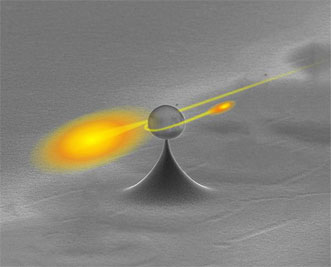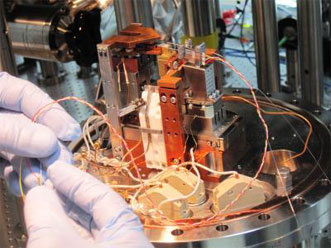REHOVOT, Israel, Dec. 8, 2015 — Separating single photons from pulses of light could enable eavesdropping on encrypted quantum communications — and it could also help make such channels more secure.
Researchers at the Weizmann Institute of Science have demonstrated how to pluck single photons out of light pulses using a setup they developed last year for optical switching. Both processes rely on single-photon Raman interaction (SPRINT), which uses a single atom of rubidium cooled and trapped by a laser to affect the trajectory of single photons in an optical fiber.

In this artist's rendering, a single photon is separated from a light pulse by a single atom near a nanofiber-coupled microresonator. Courtesy of the Weizmann Institute of Science.
Barak Dayan, head of the Weizmann Quantum Optics Group, told Photonics Media that SPRINT could be used to intercept information transmitted over quantum communications systems.
"It could be used to attack imperfect systems, in which sometimes two photons are sent instead of one," Dayan said via email. "Our system is the first that could respond to that situation, namely make sure one photon continues 'unharmed,' and snatch any others that may accidentally arrive. Alternatively, it could be used to purify your own cryptography systems, making sure they send only one photon."
The experimental setup involves a single rubidium atom near a nanofiber-coupled microresonator. Linear loss limits the single-photon extraction probability of the current setup, though probabilities near unity should be attainable, the researchers said.

The all-optical switch created by Dayan's group in 2014. Courtesy of the Weizmann Institute of Science.
Past attempts at photon subtraction involving low-reflectivity beamsplitters had inherent low success rates, and also involved detection schemes in which the separated photon is lost, Dayan's team wrote in a paper published in Nature Photonics (doi: 10.1038/nphoton.2015.227).
SPRINT, on the other hand, is a passive technique that involves only the interaction between a single atom and an optical pulse, with no other control fields.
Meanwhile, other research groups and companies continue to develop methods for generating single photons for quantum communications and fundamental research purposes. Dayan said that although SPRINT can mediate single photons, it's not an ideal way to generate them because it often affects their purity by introducing phase noise.
In previous research, Dayan's team used SPRINT as a switch or router that allowed single photons to continue on their path down an optical fiber or reflected them back toward their source. The switch also allowed control of the photons' polarization.
The position of the switch — whether it transmitted or reflected photons — was itself controlled by light, meaning the system holds promise as an all-optical router for single photons encoded with quantum information, or qubits.
Findings on the router application were published in Science (doi: 10.1126/science.1254699).
In addition to quantum communications applications, diverting single photons from a light pulse could create nonclassical states of light useful for basic scientific research, according to Dayan's team.
Funding for the work came from the Benoziyo Endowment Fund for the Advancement of Science, Crown Photonics Center, Rothschild Caesarea Foundation and Deloro Institute for Advanced Research in Space and Optics.